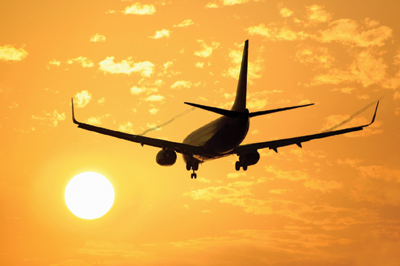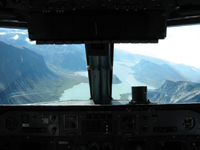
Air-rescue pilots, who travel in and out of Alberta’s wide-open skies,
want to know whether the actions performed by personnel in emergency
planes and helicopters, while attempting to rescue individuals after a
typical storm in central Alberta, are worth the risks involved.
How chiropractic can impact aviation

|
Air-rescue pilots, who travel in and out of Alberta’s wide-open skies, want to know whether the actions performed by personnel in emergency planes and helicopters, while attempting to rescue individuals after a typical storm in central Alberta, are worth the risks involved.
The summer of 2008’s back-to-back hailstorms stunned the tightly knit aviation community, and raised some tough questions related to whether or not current air-emergency programs were safe. Was the implementation of these programs justified when they risked the lives of aviators? Flying alongside a storm, and spraying silver iodine to promote hail suppression, fog clearing and snow pack augmentation, was a dangerous operation performed by Weather Modifications, Inc. (Red Deer) and other storm chasers.
“The trouble is our aviators only work in Central Alberta from July to September,” says Ben Hiebert, a pilot with Weather Modifications Inc. Hiebert goes on to report there is evidence that what they do saves lives, although a cost-benefit analysis is another matter, particularly when one considers being an employee is seasonal employment.1
 |
|
| Inside an aircraft flying from Central Alberta to the Arctic. Photo by Ben Hiebert |
Furthermore Hiebert states, “I can’t say what we do reduces morbidity and mortality for other aviators, but I can’t say we don’t, either.”
This may lead us to ask, what have we done for ourselves to promote a safer, healthier and more active lifestyle? Though riding in a rescue plane or helicopter has its risks, the Canadian Air Search and Rescue Association (CASARA) in Red Deer, Alberta, has made significant strides since the mid-1980s in maintaining numerous hard-edged standards that enforce stricter health and safety procedures for its pilots, navigators, and spotters.
According to Jim Thoreson, CASARA president, “The majority of our rescue pilots thrive on the adrenaline of flying.” Recently, the association acquired its own liability policy, Workers’ Compensation Board insurance and accidental death insurance to ensure proper coverage for those engaged in high-risk activities such as air rescue.2
LINKING CHIROPRACTIC WITH AIR RESCUE
My own experiences as an airport chiropractor, and air-rescue trainee, have included learning visual search patterns, understanding the ergonomics of an aircraft, and providing health tips for aviators. To truly understand what rescue pilots and passengers experience during the search for a missing person – despite my hearing impairment – I volunteered as “spotter.” What I really appreciated and enjoyed about my air-rescue encounters was that I could use my hearing aids and headset to communicate health strategies to all members of the rescue party without any difficulty – this, in itself, was a thrill for me.
The following are three different situations that demonstrate how valuable chiropractic care, nutrition, and exercise can be, when practised by private aviators as well as air search-and- rescue members:
Case 1: A 31-year-old male (storm aviator) suffered low back pain with mild leg stiffness. Muscle tightness and joint dysfunction was noted. With just one visit to his chiropractor, the patient reported no further leg stiffness, even after his nine-hour flights. He started using a cushion to support his lower back, and he completed his neck and leg stretch routines from a seated position every twenty minutes.
Case 2: A 42-year-old male (professional aviator) reported that he needed to improve his nutrition habits, lose unwanted weight, and reduce knee pain. The patient received a series of assessments and was subsequently able to alter his lifestyle. Within two months, he lost inches around his mid-section, and his knee discomfort had been eliminated. In fact, he now flies more than he used to before, due to increased attentiveness and energy levels.
Case 3: An 18-year-old male (student aviator) complained of right shoulder and neck pain. Orthopedic testing revealed a right, mild shoulder instability and severe ligament laxity. The patient received gentle joint manipulations and a series of take-home stability exercises. His discomfort was resolved within three visits.
Today, all pilots are required to ensure the flight fitness of their airplanes, while also removing any and all potential hazards, before taxiing down and taking off from the runway.3 It is also imperative that all aviators take the initiative to reach their own optimal health level while continuing to promote the safety of their passengers.4 Given the status of fitness many pilots appear to be in, one would think that it takes less effort for aviators to tolerate pain and discomfort than it does to implement strategies that improve their well-being.
The skies can remain wide open as long as aviation professionals continue to take care of themselves and their colleagues in the air travel industry. •
References:
- Hiebert, Ben. Interview and Conversation. Weather Modifications Inc. 15 Aug. 2008.
- Thoreson, Jim. Interview and Conversation. Search and Rescue Aviator and President. Canadian Search and Rescue Association. 6 Sept. 2008.
- Occupational Health & Safety (Waco, Tex.). Occup Health Saf. Jun 2007; Vol. 76 (6), pp. 100-3.
- Stechchulte, Pattie. Pennsylvania Chiropractor Care for Morgue Workers at Somerset Crash Site. Today’s Chiropractic. Nov 2001; pp. 30-31.
Print this page